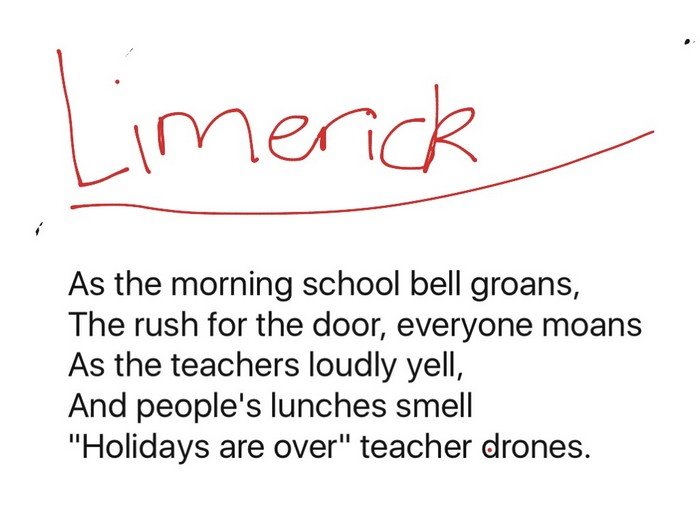Explanation of Acrostic Poems
Acrostic poems represent a unique form of poetry where the initial letters of each line, when read vertically, spell out a word, phrase, or name. This technique adds a layer of hidden meaning or message within the poem’s structure. For example, in a simple acrostic poem where the word is “LOVE”:
L ovely and warm, your smile brightens my day
O nly you can make my heart dance this way
V ivid memories of our time together
E ternal love, growing stronger than ever
Here, the first letters of each line spell out “LOVE,” revealing the underlying theme of the poem.
Characteristics of Limericks
Limericks, on the other hand, are renowned for their playful and often bawdy nature. They consist of five lines with a distinctive AABBA rhyme scheme. The structure typically includes a rhythmical pattern known as anapestic meter, where the first, second, and fifth lines contain three feet (da-da-DUM) and the third and fourth lines contain two feet.
An example of a classic limerick
There once was a man from Peru (A)
Who dreamt he was eating his shoe (A)
He woke with a fright (B)
In the middle of the night (B)
To find that his dream had come true! (A)
Limericks are characterized by their humorous content and the satisfaction of a punchline often found in the fifth line.
Can Limericks Be Acrostic?
The question arises whether limericks, with their structured rhyme and meter, can effectively incorporate acrostic elements. While limericks traditionally focus on maintaining a specific rhythmic and comedic structure, there is room for experimentation. The challenge lies in balancing the acrostic requirement with the limerick’s inherent constraints.
Examples and Demonstrations
Consider a limerick that attempts to incorporate an acrostic element:
Lazy old dog in the sun, he lays down (L)
Impervious to all calls with a frown (A)
My, he’s quite a sight (Z)
Eyes closed, soaking up the light (Y)
Not a care, just enjoying his own crown (Y)
In this example, the first letters of each line spell out “LAZY,” subtly integrating the acrostic element while maintaining the limerick’s structure and humor.
Historical or Modern Usage
Historically, limericks have been less associated with acrostic forms due to their emphasis on rhyme and rhythm. However, modern poets and enthusiasts have occasionally experimented with merging these forms to create innovative pieces. Contemporary poetry collections and online platforms sometimes feature limericks that employ acrostic techniques as a creative twist.
See also: Does A Limerick Have To Have 8 Syllables?
Creative Challenges and Community Engagement
Creative challenges and competitions often encourage poets to explore unconventional forms like acrostic limericks. Online communities dedicated to poetry frequently host themed challenges where participants are invited to create limericks with acrostic elements. These initiatives foster creativity and provide a platform for poets to showcase their skills while maintaining the limerick’s hallmark wit and humor.
In conclusion, while limericks traditionally adhere to a specific rhyme and meter, the integration of acrostic elements adds a new dimension of creativity and complexity. Whether in historical contexts or modern experimentation, the fusion of limericks and acrostic poems demonstrates the evolving nature of poetic forms and the enduring appeal of structured yet innovative expression in poetry.
FAQs About Acrostic and Limerick Poetry
1. What country did acrostic poetry come from?
Acrostic poetry has roots dating back to ancient civilizations, including Greek and Hebrew cultures. It was used as a literary device in various forms of poetry and prose across different historical periods. The exact origin country of acrostic poetry cannot be pinpointed to a single place, as it has been utilized in diverse cultures throughout history.
2. What is acrostic limerick?
An acrostic limerick is a poetic form that combines the structure of a limerick with the acrostic technique. In this form, the initial letters of each line spell out a word, message, or name vertically. This creative fusion challenges poets to maintain the limerick’s distinctive rhyme scheme and meter while incorporating the acrostic element, adding an additional layer of meaning or playfulness to the poem.
3. Did limericks originate in Ireland?
Limericks are named after the city of Limerick in Ireland, but their exact origin story is debated. While the term “limerick” as applied to this form gained popularity in the 19th century, the poetic structure and humor associated with limericks likely evolved from earlier forms of humorous and bawdy verse found in various cultures. Therefore, while they are associated with Ireland due to their name, limericks are not exclusively Irish in origin.
4. Can a limerick have more than one verse?
No, traditionally, a limerick consists of a single verse. It follows a strict five-line structure with a specific rhyme scheme (AABBA) and meter (anapestic), where the first, second, and fifth lines rhyme with each other, and the third and fourth lines rhyme separately. Limericks are known for their succinctness and ability to deliver a punchline or humorous twist within this compact form. Multiple limericks can be strung together to form a sequence, but each individual limerick remains a single verse.

